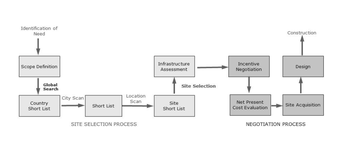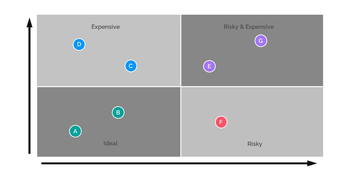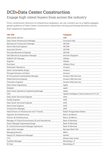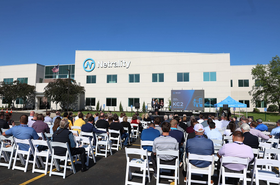Site selection in the data center industry involves a complex interplay of numerous factors, each influencing the quality, efficiency, and cost-effectiveness of the facility.
The process begins with a well-defined approach, utilizing steps outlined in a structured selection process.
This enables quantitative analysis of various criteria, transforming raw data into actionable insights that inform decision-making.
Figure 1 – From site selection to a construction decision
Trade-offs are inevitable, requiring careful consideration of competing priorities to arrive at a final site selection.
Figure 2 – Grading matrix for site selection
Every potential site has advantages and trade-offs, but with modern construction innovations, you can mitigate many of them. An engineering solution can overcome many challenges presented by a site location. For example, a site located in a hurricane zone might feature a hardened exterior exceptionally resistant to natural or physical threats like excessive wind speeds.
Early identification of crucial issues helps mitigate risks and enables building in a challenging location. Every mitigation solution will present a cost-benefit analysis that may impact capital or operation costs. Selecting a site from many potential options may present a grading system that will help in providing the right optics for the ultimate selection decision.
Climate considerations are paramount, with weather conditions impacting hazard exposure and vulnerability. Mitigating natural hazards such as floods, earthquakes, and hurricanes through engineered solutions is essential. Access to major highways and airports ensures logistical efficiency, particularly during construction and operation. The air quality surrounding a site affects equipment performance and employee health, necessitating measures to mitigate pollution. Historical data on natural disasters informs risk management strategies and facility design.
Ground conditions must undergo thorough geotechnical investigation to assess structural stability and suitability for construction. The availability of robust communications infrastructure, particularly fiber-optic networks, is critical for seamless connectivity. Low latency, enabled by proximity to subsea cable landing sites and dense fiber networks, is imperative for high-performance applications.
Geopolitical stability, regulatory environments, and taxation policies influence site selection decisions. Electrical power availability and cost significantly impact operational expenses, with renewable resources offering sustainability benefits. Local incentives, such as tax exemptions and regulatory support, may sway decisions.
Community engagement is crucial, with operators addressing concerns and highlighting benefits to stakeholders. Unforeseen challenges, such as construction complexity and vendor coordination issues, underscore the importance of skilled project management.
Retrofitting existing commercial buildings for data center use offers cost-effective alternatives but requires careful assessment of power, HVAC, zoning, and security considerations. Clustering around peering points fosters innovation and connectivity, with historical trends showing telecom companies initiating clusters later joined by hyper-scale operators.
Due diligence
Despite the complexities involved, meticulous due diligence ensures secure ownership and regulatory compliance. Overall, successful site selection hinges on comprehensive analysis, stakeholder engagement, and risk mitigation strategies.
There are perhaps two limbs of approach to selecting a site driven from different starting positions. In the first part, you may have the developer-type entity with local knowledge of a potential area and then develops a proposal to the data center market and takes what may be termed a bottom-up approach.
These developers often operate with private equity as the financial market continues to see a strong appetite for data centers from investors who are starting to view data centers in the same investment grade category as more traditional real estate sectors. The equity investors may cover the site due diligence cost, design, and legal cost to the planning permission stage with the objective of a staged exit once an interested data center operator engages. The legal title of the land is generally not transferred until the final operator is ready to procure. Option agreements, site assembly, and development, are the preferred paths of seed investors.
An option to purchase is an incredibly useful tool for a data center developer seeking to assemble ownership of a site for a development scheme. Several different parties may own the land that comprises the intended development site. Using options to acquire these interests can provide the developer with the required combination of certainty and flexibility to exit if an end purchaser for the scheme does not materialize.
These investors may enter a joint venture special propose vehicle type company (SPV) with the site developer to attract end-user clients before or after the grant of planning permission or license stage. A waterfall model is often used to umbrella multilabel parties in a shared investment. It is a term used in a Legal Operating Agreement that describes how money is paid, when, and to whom in the development of equity investments.
In short, once various predetermined milestones are achieved, the initial promotor may receive a more significant portion of the cash flows in proportion to their equity invested when the deal was initially acquired, also known as promoted interest. Each waterfall structure is different and requires considerable expertise.
The second part of sourcing a data center site is the mega-scale entity with a global need and a regional focus, which peruses what may be termed a top-down approach. Once these entities have identified their market need, they look at multiple locations within diverse jurisdictions. Many specialist estate agents are in the mix of these two binary parts, engaging with both entities to bind a deal.
To have a successful site that will mature into a development project and an operational data center, one needs to consider and provide weighting to the criteria in selecting a site. All too often, expensive oversights and omissions in due diligence in site selection become evident during the build and operational phase.






